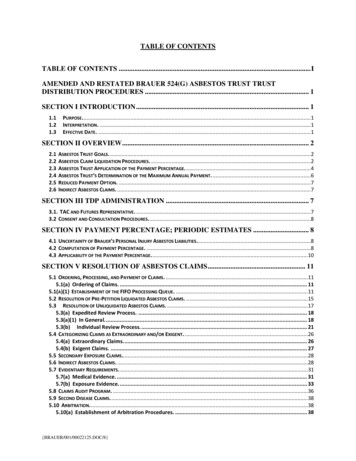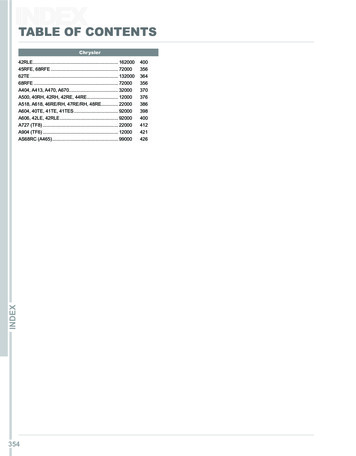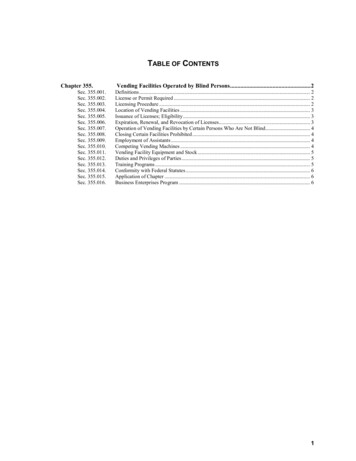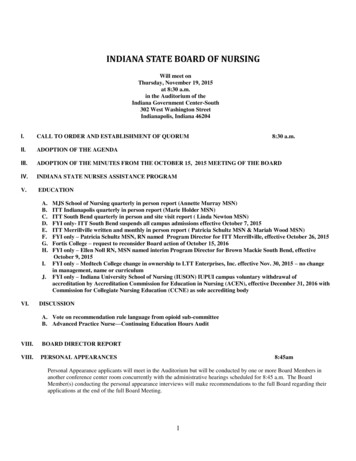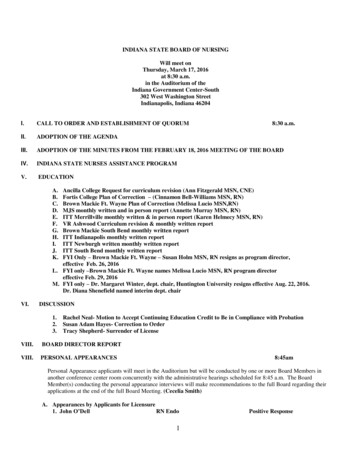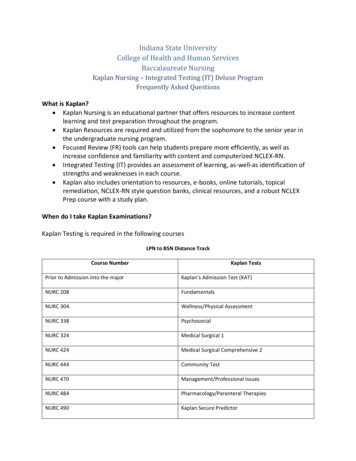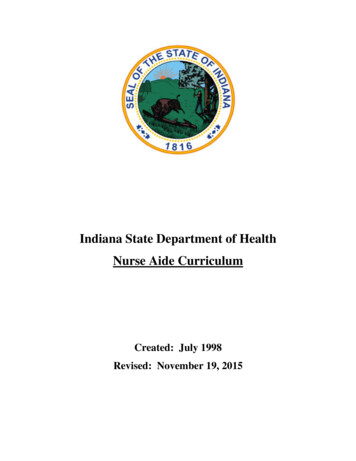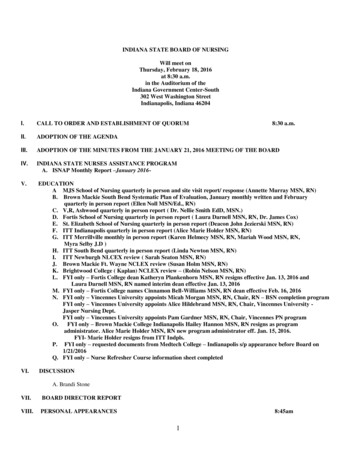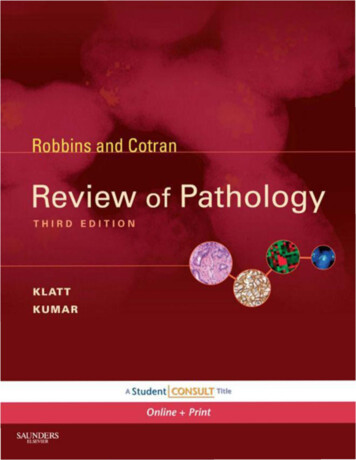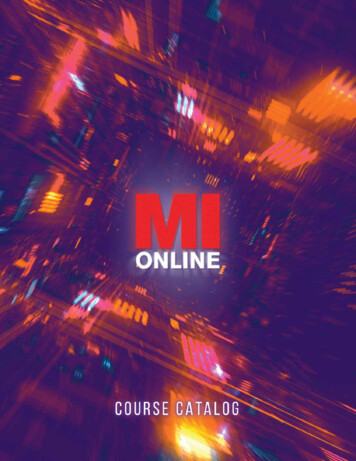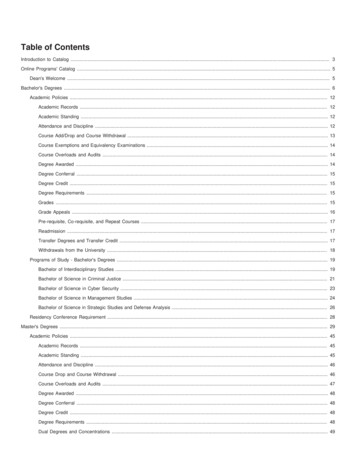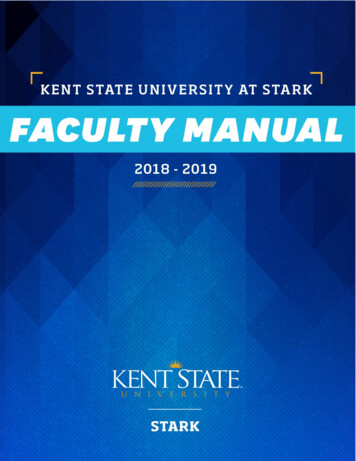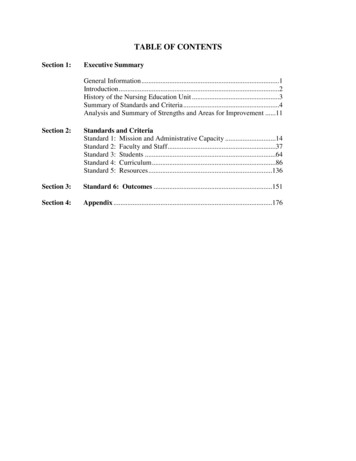
Transcription
TABLE OF CONTENTSSection 1:Executive SummaryGeneral Information .1Introduction .2History of the Nursing Education Unit .3Summary of Standards and Criteria .4Analysis and Summary of Strengths and Areas for Improvement .11Section 2:Standards and CriteriaStandard 1: Mission and Administrative Capacity .14Standard 2: Faculty and Staff .37Standard 3: Students .64Standard 4: Curriculum .86Standard 5: Resources .136Section 3:Standard 6: Outcomes .151Section 4:Appendix .176
LIST OF TABLES AND FIGURESTables1.1.1Page(s)Comparison of Mission and Values Statements Between University,College, and Departments . 14-151.2.1 All Nursing Faculty Participation on Senate and Standing UniversityCommittees.231.2.3 Current BN and BNC Faculty Participation on CONHHS Committees .241.2.4 Executive Director of Nursing Committee Participation .251.2.5 Student Representation on Department Committees.261.3.1 Department of Baccalaureate Nursing Advisory Committee Members .271.3.2 Department of Baccalaureate Nursing Completion Advisory CommitteeMembers.271.10.1 University Policies Regarding Faculty and Staff .341.10.2 Differing Policies for Nursing Faculty and Supporting Rationale .351.11.1 Comparison of University Mission Statement, Department ofBaccalaureate Nursing Completion Mission Statement, andPhilosophy of the Nursing Faculty .362.1.1 Faculty Profiles, Baccalaureate Nursing Program (Full-Time). 38-422.6.2 Faculty Scholarship . 49-572.7.1 Staff Who Support the Baccalaureate Program . 58-593.1.1 Examples of Similarities Between the Governing Organization andthe Baccalaureate Nursing Program . 64-673.1.2 Examples of Differences between the Governing Organization and theBaccalaureate Nursing Program . 67-693.1.3 Examples of Differences in Policies Between the BaccalaureateNursing Completion (LPN to BS and RN to BS) and the CampusBaccalaureate Nursing Tracks . 70-723.4.1 Indiana State University Student Support Services . 74-773.4.2 Additional Support Services available for nursing students . 77-783.6.1 Indiana State University Student Default Rates .814.1.1 Comparison of AACN BSN Essentials, IOM/QSEN CoreCompetencies and the Baccalaureate Program New Graduate Outcomes . 89-914.2.1 Roles and Leveled Student Learning Outcomes in the CurrentBaccalaureate Nursing Program . 92-964.2.2 Leveled Student Learning Outcomes for the Revised BaccalaureateNursing Program . 96-984.2.3 Examples of SLOs with Instructional Delivery Method, LearningActivities, and Evaluative Methods for Old Curriculum for BN . 99-1014.2.4 Examples of SLOs with Instructional Delivery Method, LearningActivities, and Evaluative Methods for Old Curriculum for BNC . 101-1034.2.5 Examples of SLOs with Instructional Delivery Method, LearningActivities, and Evaluative Methods for New Curriculum for BN . 103-1044.2.6 Examples of SLOs with Instructional Delivery Method, LearningActivities, and Evaluative Methods for New Curriculum for BN . 104-1054.4.1 Foundational Studies Requirements Not Included in Cognates/MajorCourses .1084.4.2 Traditional Track Required Cognate (non-nursing) Courses . 108-1094.4.3 Accelerated Second Degree Required Prerequisites (non-nursing) Courses .109
.3.16.4.3.26.4.4.16.4.4.26.4.5.16.4.5.2LPN to BS Required Cognate (non-nursing) Courses . 109-110RN to BS Required Cognate (non-nursing) Courses.110Examples of Cultural, Ethnic, Socially Diverse Concepts Across theCurriculum (Old/New) . 110-113Instructional Process and Current Standards of Practice .114Examples of Interprofessional Interaction . 115-116BN Curriculum Evaluative Methods . 117-118LPN to BS Evaluative Methods .118RN to BS Evaluative Methods . 118-119Cognitive Test plan for Traditional, LPN and RN to BS-revisedCurriculum .120Cognitive Test plan for Accelerated Track .120Cognitive Test plan for Traditional, LPN and RN to BS -OldCurriculum .121BN curriculum credit and contact hours. 123-124Accelerated BS Curriculum .124BNC LPN to BS Credit and Contact hours . 124-125BNC RN to BS Credit and Contact hours . 125-126Agency Sites . 128-132Physical space dimensions by room type in Nursing Building .140Learning Resources Equipment . 142-144RHIC Simulation Center Inventory List . 145-147Baccalaureate Assessment Methods to Determine StudentAchievement of Learning Outcomes . 152-153Examples of Data-Driven Action Plans for Improvement forBaccalaureate program . 153-156NCLEX-RN Licensure Exam Rates (2011-to date) .157Program Completion – BN Traditional(Old Curriculum, last admission fall 2012) .161Program Completion - BN Traditional(Revised Curriculum, first admission spring 2013) .162Program Completion – BN Accelerated(Revised Curriculum only, first admission summer 2011) .162Program Completion - LPN to BS .163Program Completion - RN to BS.164Student Program Satisfaction – Traditional Graduates,LPN to BS, RN to BS, fall 2010 to spring 2013 .167Student Program Satisfaction – Accelerated Graduates,summer 2012, summer 2013 .168Employer Program Satisfaction – Traditional Graduates,LPN to BS, RN to BS, fall 2011 to spring 2013 .171Employer Program Satisfaction – Accelerated Graduates,summer 2012 .171Job Placement Rates for Traditional, LPN to BS and RN to BS,fall 2010 to spring 2013 .174Job Placement Rates for Second Degree Accelerated, summer 2012.175
Figures1.2.11.2.21.2.31.2.4Page(s)College of Nursing, Health, and Human Services Organizational Chart .19Department of Advanced Practice Nursing Organizational Chart.20Department of Baccalaureate Nursing Organizational Chart.21Department of Baccalaureate Nursing Completion Organizational Chart .22
EXECUTIVE SUMMARYGENERAL INFORMATION:1. Program type being reviewed, purpose and dates of visit:Baccalaureate DegreeContinuing ApprovalFebruary 18-20, 20142. Name and address of governing organization:Indiana State University200 North 7th StreetTerre Haute, IN 478093. Name, credentials, and title of chief executive officer of the governing organization:Dr. Daniel J. Bradley, Professor and President4. Name of the governing organization’s accrediting body and accreditation status:The Higher Learning Commission of the North Central Association of Colleges andSchools. Full accreditation awarded in March 2011.5. Name and address of the nursing education unit:Departments of Baccalaureate Nursing, Baccalaureate Nursing Completion, andAdvanced Practice NursingCollege of Nursing, Health, and Human Services749 Chestnut StreetTerre Haute, IN 478096. Name, credentials, and title of the nurse administrator of the nursing unit:Dr. Lea R. Hall, PhD, MS, BSN, Associate Professor and Executive Director of Nursing7. Telephone, fax number, and email address of the nurse administrator:Telephone: (812) 237-2326Fax number: (812) 237-8895E-mail: lea.hall@indstate.edu8. Name of the State Board of Nursing and approval status (date of last review andaction):Health Professions BureauIndiana State Board of NursingIndianapolis, INhttp://www.in.gov/pla/nursing.htmApproval status: Full accreditation for all programs9. ACEN Accreditation Standards and Criteria used to prepare the Self-Study Report:2013 Accreditation Standards and Criteria, Baccalaureate1
INTRODUCTION:Indiana State University (ISU), a public institution, was founded in 1865 as IndianaNormal School with its primary mission being to prepare teachers for Indiana’s schools.Enrollment has increased from 21 students in the first class to nearly 13,000 during the 20122013 academic year. ISU is located at the Crossroads of America in Terre Haute, Indiana, whichis the state’s twelfth largest city. According to the most recent census data, the city’s estimatedpopulation is 61,112. While the median age of residents is 32.7 years, there are approximately7,600 (12.6%) individuals who are age 65 or older. Ethnic diversity is low, with nearly 84% ofthe population being Caucasian. Terre Haute offers a variety of cultural, historic, andeducational enrichment opportunities to the University community.ISU has six academic divisions, each headed by a Dean who reports to the Provost andVice President for Academic Affairs. The divisions include: the Colleges of Arts and Sciences;Business; Education; Nursing, Health, and Human Services; Technology; and, the College ofGraduate and Professional Studies.ISU offers baccalaureate, master’s, specialist, and doctoral degrees. The University isaccredited by the Higher Learning Commission of the North Central Association of College andSchools, http://www.ncahigherlearningcommission.org, and received a ten-year reaccreditationin 2011. Academic programs across the colleges are accredited by more than 30 differentagencies. In addition, the University holds institutional membership in at least 10 major nationalassociations.The basic Carnegie classification for ISU is Doctoral/Research Intensive University.Institutions with this label offer a wide range of baccalaureate programs and are committed tograduate education through both Master’s and Doctoral degrees. ISU offers over 80 majors in avariety of areas including arts and sciences, business, criminology and criminal justice,education, nursing, health, and human services, and technology.The University is governed by a Board of Trustees, and administered by a President, whois the University’s Chief Executive Officer. The University is organized into the followingmajor functional areas: Academic Affairs; Business Affairs and Finance; EnrollmentManagement, Marketing and Communications; and Student Affairs. The University Presidentdelegates the administration of each of these functional units to a Vice President. Each of the2
functional areas is organized into related administrative divisions, departments, units, andoffices.The College of Nursing, Health and Human Services (CONHHS) has seven academicdepartments: Advanced Practice Nursing; Applied Health Sciences; Applied Medicine andRehabilitation; Baccalaureate Nursing; Baccalaureate Nursing Completion; Kinesiology,Recreation and Sport; and Social Work. The baccalaureate nursing program has multiple trackswithin the Departments of Baccalaureate Nursing (BN) and Baccalaureate Nursing Completion(BNC). The Department of BN consists of the traditional campus track and the acceleratedsecond degree track. The Department of BNC consists of the distance LPN to BS and the RN toBS tracks. The Baccalaureate Program has a total enrollment of 657 for spring 2014. Thenumber of students enrolled by track is as follows: Traditional 265; Accelerated Second Degree27; LPN to BS 243; RN to BS 122.The Baccalaureate program has 22 full-time faculty assigned to teach among the programtracks. The number of part-time faculty fluctuates slightly from semester to semester. As ofJanuary 2014, there are 23 part-time faculty teaching in the baccalaureate program among thevarious tracks.HISTORY OF THE NURSING EDUCATION UNIT:ISU School of Nursing opened its doors to students in September 1963 and was initiallyfully accredited in 1969 by the National League for Nursing Accrediting Commission, Inc.(NLNAC). Upon successful completion of the four-year program, student received a Bachelorof Science degree. The first class of students graduated for the ISU School of Nursing in 1967.After a series of relocations, in 1971 the School of Nursing moved to its current location. Inaddition to offices for faculty and administrators, the building houses classrooms and a LearningResource Center (LRC).Major curricular revisions and innovations have taken place over the years. In responseto community needs and the phase-out of local diploma programs in nursing, the first majorrevision occurred in fall of 1977. The four-year, generic baccalaureate nursing program wasreplaced with a four-year baccalaureate nursing program and provided the option to exit uponcompletion of the two-year associate degree nursing program. The first class of students enteredin 1977 and graduated in 1979. The program was initially full accredited by the NLNAC in1980. The associate degree nursing program closed in 2005. In fall 1998, the Baccalaureate3
track for Registered Nurses (RN to BS) was initiated to meet educational needs of practicingregistered nurses. By 2000, all courses in the track were delivered online. The Baccalaureatetrack for Licensed Vocational or Licensed Practical Nurses (LVN/LPN to BS) began in fall2003, and all courses in this track are delivered online.In 1986, a program of graduate nursing studies leading to a Master of Science degree wasinitiated. The first class completed requirements in 1988, and the program received fullaccreditation by the NLNAC in 1989. The FNP concentration was offered online starting in fall2004, and the Nursing Education and Nursing Administration concentrations followed thereafter.Work began in 2009 to develop the DNP program at ISU. The first cohort of students wasadmitted in fall 2010 and graduated in spring 2012. The DNP program received full initialaccreditation by the NLNAC in 2013 and is entirely online.In 2006, the Provost of the University charged a task force with developing a morecomprehensive college to be focused on programs and services in the health related area. In its2007 report to the Provost, the task force found that other universities were successful in formingcolleges of health that strengthened and supported training in health professions. As a result, theCollege of Nursing, Health, and Human Services (CONHHS) was created from merging theCollege of Nursing and the College of Health and Human Performance and, in 2007, approval todo so was received from the Indiana Commission on Higher Education. In 2008, departmentswithin the CONHHS were established. Nursing transitioned from one department, theBaccalaureate and Higher Degree Department, into the following three departments: Departmentof Baccalaureate Nursing; Department of Baccalaureate Nursing Completion; and Department ofAdvanced Practice Nursing.The traditional baccalaureate track can be completed in 4 years and with proposedrevisions has 120-123 total credits. The accelerated second degree track can be completed in 15months or four semesters and has 82 total credits. The LPN to BS track and RN to BS track aregenerally completed on a part-time basis. Full-time the LPN to BS track can be completed in 6semesters and has a total of 120 credits. The RN to BS track can be completed in 4 semesters offull-time study and has a total of 120 credits.SUMMARY OF STANDARDS AND CRITERIA:Standard 1: Mission and Administrative Capacity4
The mission statement and core values of the CONHHS are based on respect, integrity,compassion, health, and performance. The mission and philosophy of all nursing departments inthe CONHHS are congruent with the mission and purpose of ISU. Table 1.1.1 indicatedalignment of the mission statements between the University, and the nursing unit. TheUniversity is governed by a Board of Trustees whose members are governor-appointed and whowork closely with administrators and faculty to implement the mission of the University and theCollege. Faculty, administrators, students, staff, and the public have access to the Board ofTrustees and may communicate with members through the Board Liaison via e-mail and regularcorrespondence via the United State Postal Service. Administrators and faculty have authorit
4.8.2 Accelerated BS Curriculum . Indiana State University (ISU), a public institution, was founded in 1865 as Indiana . ISU School of Nursing opened its doors to students in September 1963 and was initially fully accredited in 1969 by the National League for Nursing Accrediting Commission, Inc.
